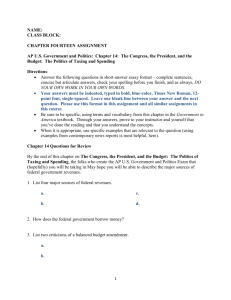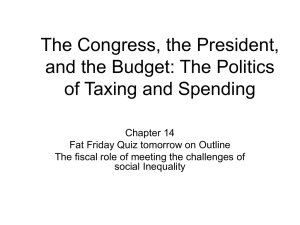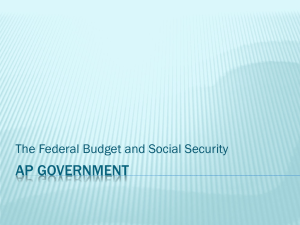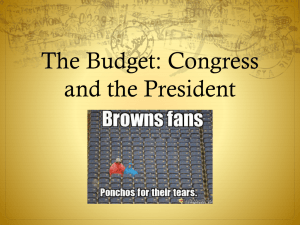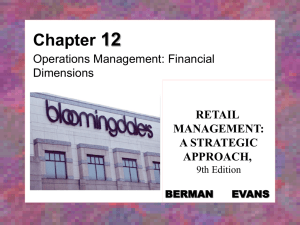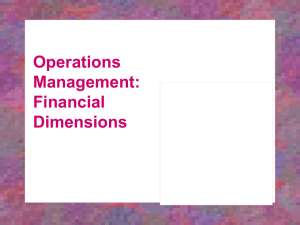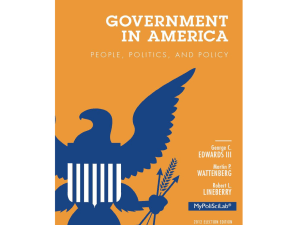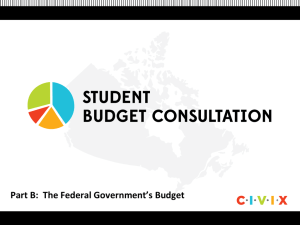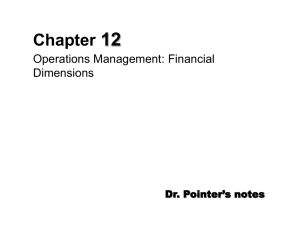0321338464_14
advertisement
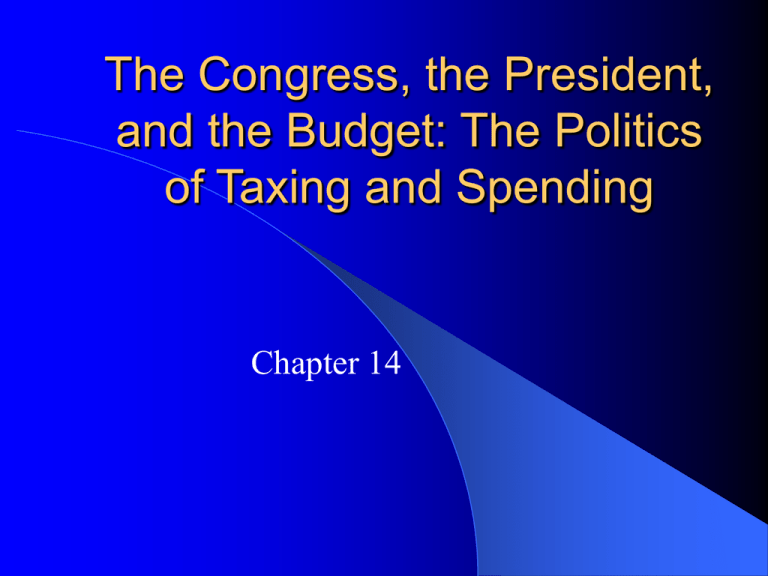
The Congress, the President, and the Budget: The Politics of Taxing and Spending Chapter 14 Introduction Budget: – A policy document allocating burdens (taxes) and benefits (expenditures). Deficit: – An excess of federal expenditures over federal revenues. Expenditures: – What the government spends money on. Revenues: – Sources of money for the government. Sources of Federal Revenue Income Tax – Shares of individual wages and corporate revenues. – The 16th Amendment permitted Congress to levy an Income tax. – The individual part is the largest single revenue source for the government. – Income tax is progressive: Those with more income pay higher rates of tax on their income. Sources of Federal Revenue Social Insurance Taxes– Additional taxes for specific fund: Social Security and Medicare Figure 14.1 Sources of Federal Revenue Borrowing – The Treasury Department sells bonds - this is how the government “borrows” money. – The federal debt is the sum of all the borrowed money that is still outstanding. – The government competes with other lenders. – Government does not have a capital budget. Sources of Federal Revenue Total National Debt Figure 14.2 Sources of Federal Revenue Taxes and Public Policy – Tax Loopholes: Tax break or benefit for a few people - not much money is lost. – Tax Expenditures: Special exemptions, exclusions, or deductions - lots of money is lost. – Tax Reduction: The general call to lower taxes. – Tax Reform: Rewriting the taxes to change the rates and who pays them. Sources of Federal Revenue Federal Expenditures Figure 14.3 Federal Expenditures Big Governments, Big Budgets – A big government requires lots of money. – As the size of government increases, so does its budget. The Rise and Decline of the National Security State – In the 50’s & 60’s, the DOD received more than half the federal budget. – Defense now constitutes about one-sixth of all federal expenditures. Federal Expenditures Trends in National Defense Spending (Figure 14.4) Federal Expenditures The Rise of the Social Service State – The biggest part of federal spending is now for income security programs. – The biggest of these is Social Security. – Social Security has been expanded since 1935 to include disability benefits and Medicare. – These benefit programs face financial problems with more recipients living longer. Federal Expenditures Trends in Social Service Spending (Figure 14.5) Federal Expenditures Incrementalism – The idea that last year’s budget is the best predictor of this year’s budget, plus some. – Agencies can safely assume they will get at least what they got last year. – Focus & debate on the increase over last year. – The budgets tend to go up a little each year. Federal Expenditures “Uncontrollable” Expenditures – Spending determined by the number of recipients, not a fixed dollar figure. – Mainly entitlement programs where the government pays known benefits to an unknown number of recipients - Social Security. – The only way to control the expenditures is to change the rules. The Budgetary Process Budgetary Politics – Stakes and Strategies All political actors have a stake in the budget. All actors try and tie their budget needs to national or political needs. – The Players Lots of players, with the president and Congress playing important roles. Almost all committees are involved in the budget. The Budgetary Process The President’s Budget – Presidents originally played a limited role in the budget. – Now budget requests are directed through the OMB and president before going to Congress. – The budget process is time consuming - starting nearly a year in advance. – The OMB, the president, and the agencies negotiate over the budget requests. The Budgetary Process The Budgetary Process Congress and the Budget – Reforming the Process. Congressional Budget and Impoundment Control Act of 1974 did much to reform the process. A fixed budget calendar, congressional budget committees, and the CBO were created. Budget was to be considered as a whole. A budget resolution sets the bottom line for the budget. The current budget is then reconciled. The new budget is authorized and appropriated. The Budgetary Process The Budgetary Process Congress and the Budget – The Success of the 1974 Reforms. Between 1974 and 1998, every budget was a deficit budget. Congress misses most of its own deadlines. Congress passes continuing resolutions to keep the government going until it passes a budget. Omnibus budget bills often contain policies that can’t pass on their own. The Budgetary Process Annual Federal Deficits (Figure 14.6) Figure 14.7 The Budgetary Process Congress and the Budget – More Reforms. Congress passed bills to try and control the deficits. By 1990, Congress focused on the increases in spending. Both parties claimed victory for the budget surpluses that began in 1997. Economic downturn, income tax cuts, and increased military expenditures brought a return to deficits by 2001. Understanding Budgeting Democracy and Budgeting – Many politicians “spend” money to buy votes. – With many groups and people asking for government assistance, the budgets get bigger. – Some politicians compete by trying not to spend money. – People like government programs, but they really don’t want to pay for them, thus there are deficits & the public debt. Understanding Budgeting The Budget and the Scope of Government – In sum, the budget represents the scope of government. – The bigger the government, the bigger the budget. – Limits on funding (taxes) can limit what the government can do.
